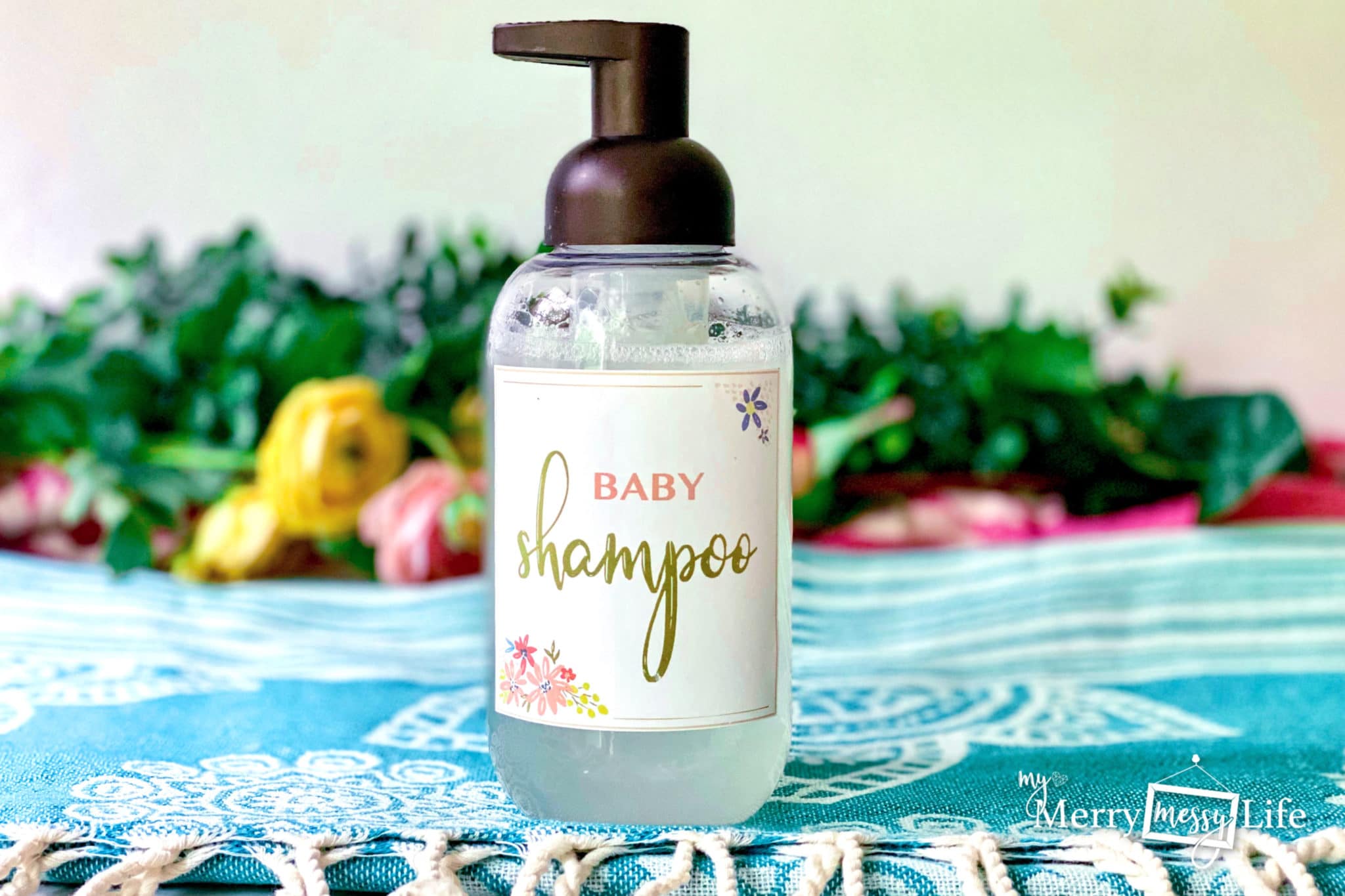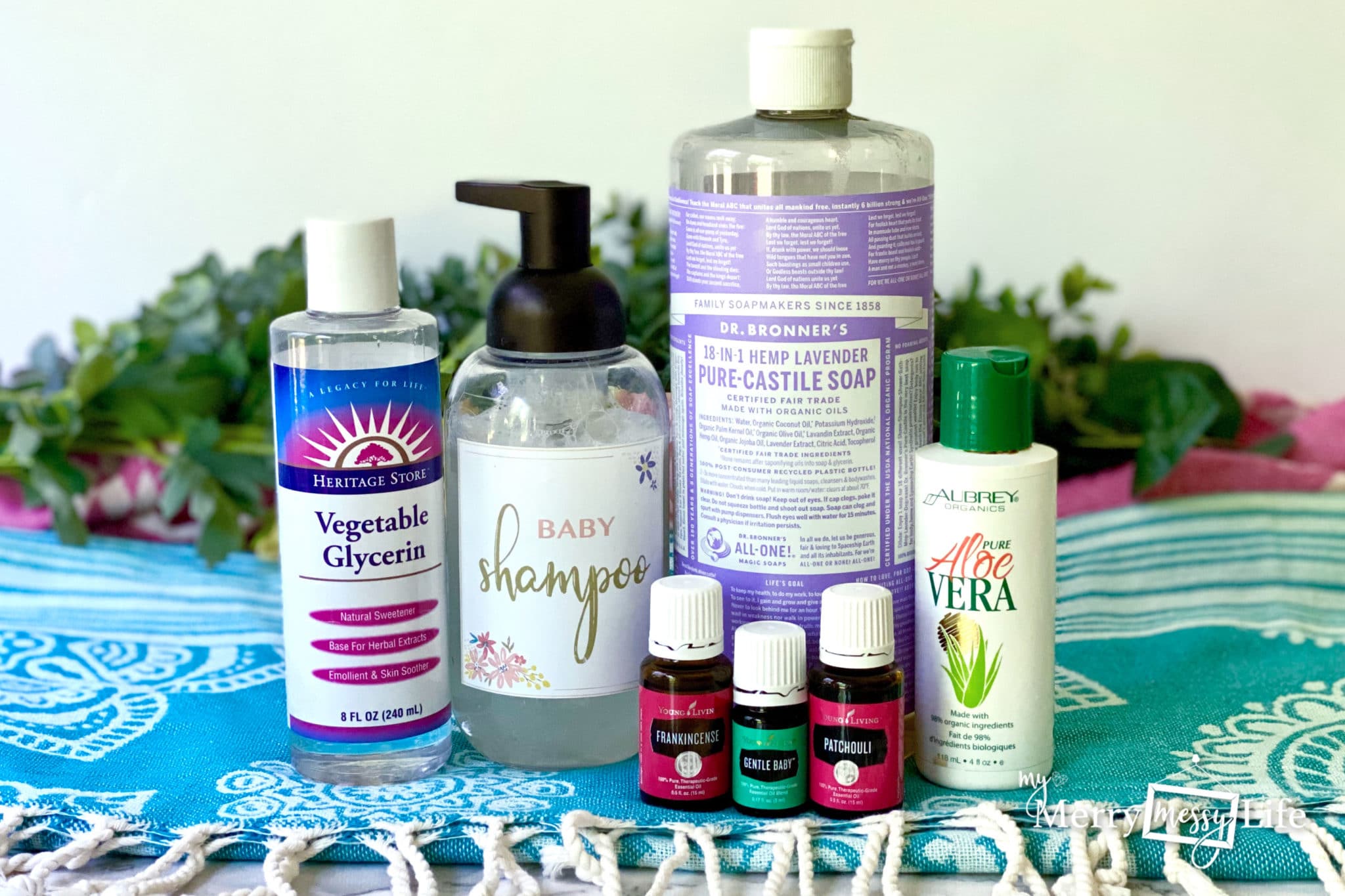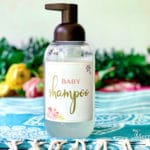DIY Natural Baby Shampoo and Body Wash Recipe
A super simple, gentle and foaming DIY natural baby shampoo and body wash for babies and even adults with dry skin using Castile Soap, glycerin or aloe vera and essential oils. I use this same formula as my body wash, too! It is non-toxic, sulfate and paraben free, and gentle on that brand new skin.

Why Make Your Own Natural Baby Shampoo?
It's Much Cheaper!
To purchase a natural baby shampoo in the stores, you can easily pay $10-$15, and even then it could be scented with artificial fragrances and not pure essential oils.
It's Much Healthier
Did you know there are toxins in most body washes and soaps on the market? Things like artificial fragrances, sulfates, and paragons.
Sodium Laureth and Lauryl Sulfate
Sulfates are harsh detergents that are great for home cleaning or washing your house and car, but are not appropriate for washing your hair or body. They are certainly too harsh and strong for a baby's delicate skin! When looking for a store-bought baby shampoo, I recommend steering clear of sulfates.
Artificial Fragrances
Artificial fragrances can trigger asthma attacks, worsen allergies, and cause inflammation in the sinuses that can lead to more frequent colds and respiratory infections. And they are in a massive amount of products in the stores and are hard to get away from! That’s why I prefer to scent my homemade products with essential oils.
Fake fragrances disperse particles of formaldehyde and phthalates (thy-lates) into the air. Phthalates are small particles of plastic that are used to bind the artificial fragrance molecules together. We then breathe in those tiny particles of plastic and they get into our nose and lungs – yuck! They are also irritating on the skin, which obviously isn't good for a sweet baby.
It’s Eco Friendly
Those same toxins listed above that are not healthy for humans also harm the environment. They harm our delicate ecosystems as they go down our drains and are polluting our drinking water and the planet. Also, when you buy the ingredients in bulk to make your own products and reuse your bottles and containers, you produce less trash and waste, which is better for our planet.

Learn About the Ingredients in This Recipe
Vegetable Glycerin
Vegetable Glycerin is a natural by-product of the soap making process. It is moisturizing but not greasy, which is why I've added it to this natural baby shampoo recipe. If your baby's skin is very dry or if they have eczema, you can increase the amount. You might even make two recipes – one for the hair with a small amount or without the glycerine, and one for the body with glycerine.
If your baby, toddler or child has curly hair, I highly recommend using the glycerin as it's in many curly hair products because it moistures and helps to detangle the hair.
Essential Oils
Essential oils are wonderful to use in homemade bath, body and beauty products. They not only make your products smell like they were created in a spa, they also have many therapeutic and health benefits! My favorite essential oils company is Young Living, and they offer some of the most beautiful and convenient starter kits on the market to make getting started with essential oils easy. Learn more about their starter kits here. I use them all of the time to keep me and my family healthy and well.
To learn more about how you can safely use essential oils for babies, check out my post here!
Castile Soap
Castile Soap is one of our natural home staples. I use it in all of our hand soaps and body washes. It lathers well and is also gentle and mild. It doesn’t contain any harsh detergents like Sodium Laureth or Lauryl Sulfate so it is wonderful to use on the body. It is an olive oil based soap that originated in the Castile region of Spain, which is where it gets its name.
I used to really struggle with dry, cracked hands, especially in the winter time when I used store bought hand soaps. Now that I use Castile Soap, I rarely even have to use lotion, even in the winter!
PrintFoaming DIY Natural Baby Shampoo and Body Wash Recipe
A foaming DIY natural baby shampoo and body wash recipe that's moisturizing, super gentle and completely nontoxic.
Ingredients
- 4 tbsp. Dr. Bronner's Castile Soap – Aloe Vera Baby Mild (unscented)
- Optional: 1 tbsp. – use either Vegetable Glycerin or Liquid Aloe Vera Gel
- Optional: 3-5 drops Essential Oils like Lavender, Ylang Ylang, Frankincense, Gentle Baby or Patchouli
- 8 oz. Foaming Soap Pump – white top, or fancier brown pump
- approx. 7 oz. water
- Printable label for your bottle
Instructions
Fill the soap bottle halfway with water. Add the Castile Soap and optional glycerine or Aloe Vera and essential oils. Gently top off with more water. Done!
Notes
The liquid Aloe Vera gel I've linked to here is a clear liquid, it is not a gel. If you use a gel, I'm not sure how that would change the consistency of the recipe and if it'll still go through the foaming pump.
I have personally found the unscented, Baby Mild, Castile Soap doesn't cause much eye irritation for my kids. But it does cause some, so this recipe isn't fully tear free.
Cost Breakdown
- Dr. Bronner's Castile Soap – $0.48/an ounce and you need 1 ounces – $0.48
- Aloe Vera Gel – $2/an ounce and you need .5 oz for a tablespoon – $1.00 OR
TOTAL: $1.48 for 8 ounces! Way cheaper than a $10 bottle at the store and it's totally pure and non-toxic.


Hi Sara, thank you for the “recipe”’! Do you know long the shampoo is good for? Does it expire after a certain period of time? Thanks again!
Hi Beth! When I make it lasts several months, so I know it lasts as long as that. It’s should be shelf stable for a long time because it doesn’t contain any food ingredients or ingredients that break down easily.
Do you shake the bottle up each time when you use it?
No I don’t have to, it stays mixed which is really nice!
Hi I noticed that the label says baby shampoo but the title of this blog says for body wash and shampoo. Can you clarify that the recipe can be used for both body and hair or just hair?
Hi Linda! Sorry for the confusion there! So yes, it’s like a baby shampoo in that it can be used on the body and hair. As the baby grows more hair or starts to grow more curly hair, I would use a conditioner after this baby shampoo.
Do you have a conditioner recipe?
Hi Linda! Yeah so the sugar is essential to the fermenting process. Without it, the tea will not be able to ferment. Within a week, nearly all of the sugar is fermented, so the kombucha has very little sugar content, if any at all. The longer you ferment it, the more it’ll taste like vinegar and have no sugar in it.
Hi! The ingredients of Castile soap already contain jojoba, coconut, and olive oils, and vitamin E. I was thinking of just diluting the soap 1:4 parts in a soap container and just using that (mostly because I’m also lazy lol). What are the benefits of adding extra oil and vitamin E? Is it necessary?
Hi Melody! No the extra ingredients are optional, for dry skin and wintertime skin. They add extra moisture but Castile Soap by itself is more moisturizing than other soaps because of how gentle it is.
What essential oils do recommend adding in for eczema?
Hi Maria! I recommend lavender, cedarwood, and frankincense. All are gentle and soothing. I have a whole blog post about how I helped my eczema if you’re interested.
Could you use fractionated coconut oil in place of the vegetable glycerin or do a mixture of both?
Would this work for a baby with dry scalp and dry senstive skin?
Hi Vera! Yes this recipe is perfect for a baby with sensitive skin and a dry scalp. The glycerine is just another moisturizing ingredient that isn’t oily. If the baby has a lot of hair, I wouldn’t use fractionated coconut oil in place of the glycerine as it’ll make the baby’s hair oily. You can eliminate that ingredient all together or replace it with another non-oily but moisturizing ingredient like liquid Aloe Vera. Hope that helps!
Hi! Have you changed this recipe? Didn’t it used to have almond oil and something else in it? I’ve used the other recipe for years, even on my now 4 year old.
Just curious about the reason for the change.
Hi Stacy! Yes I did change it about a year ago. I replaced the almond oil with vegetable glycerine because I was finding that the almond oil was making my kids’ hair oily, and the bathtub, too. But if it was working for you, then great! I’d keep using it and you won’t need glycerine.
Would I have to use this as a foaming soap, or could I use a regular pump? Also, if I used a regular pump, could I use aloe vera gel instead of the liquid? Thank you!